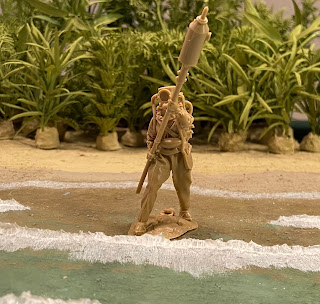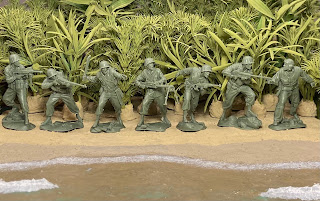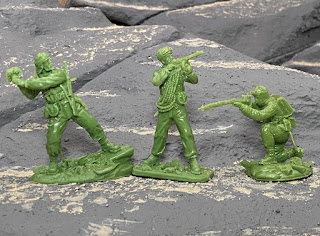The Japanese Suicide Divers (a.k.a Fukuryu in Japanese or Kamikaze frogmen in western works) were a unit within the Japanese Special Attack Units charged with the defense of the Japanese homeland in the case of an Allied invasion. The term Fukuryu means crouching dragon, which will make more sense as we describe their mode of operation. The idea was to have these men defend the landing beaches, by hiding in waiting for up to 10 hours under water at a depth of about 20 feet. They were aided by 20 lb of lead which would keep them submerged, and they were also supplied with liquid food to keep their energy levels up. They were equipped with a 16-foot bamboo pole, which had a 33 lb mine attached to it. The men were expected to jam the mine against the bottom of passing landing craft, with the understanding that the resulting explosion would kill them. An interesting tactical doctrine was developed. The divers were supposed to be deployed in a stagged formation, 20 meters apart. Additionally, in order to have protection against countermeasures, special concrete bunkers were going to be sunk into the beaches so that 6 to 18 divers could enjoy some protection while waiting. The divers were actually the middle ring of a 3-layer system of defenses. The outer-most ring was a set of mines release by trip wires as the landing craft passed through. The inner-most ring was a more conventional set of mines closer to the beach. The divers however provided a better aimed alternative. The plan was to outfit and deploy 6000 divers, however by the time of Japan surrendered, only 1200 were ready. It will never be known how effective they would have been. My feeling is after some initial successes, the marines on the landing craft would have simply sprayed the water ahead of them with MG fire or some other countermeasure and they would have neutralized the divers. I also wonder about the visibility under water, perhaps without full daylight to help outline the silhouette the ships above them, and with a potentially fogged up helmet. And then of course, the required courage to carry out the mission when nobody else is watching underwater. Anyhow, this is such a little-known topic that until Plastic Platoon did it, nobody had ever made such a Toy Soldier, and I wonder if it will happen again any time soon. Let's take a look.
Dedicated to exploring the world of Plastic Toy Soldiers. The focus is WWII figures & vehicles in 1:32 (54mm), although there's also a bit of Vietnam. If you grew up playing with them or simply love to collect them, this is the place for you. The posts are organized by Manufacturer & by Country/Service branch. Use the menu of labels on the right side of the blog to find what interests you. Comments are welcome. Please note that this site uses Google Analytics & AdSense cookies.
Google Analytics
Auto Ads
Search This Blog
Monday, March 14, 2022
Introducing the Japanese Fukuryu Divers
Sunday, March 13, 2022
Introducing the US Paramarines
The US Paramarines (a.k.a. Marine Paratroopers) were a unit within the US Marine Corps that existed between 1940 and 1944. The idea, as with other airborne troops, was to use them for raids behind enemy lines. Three battalions were formed, and while they did see combat, none of them was ever used for an airborne operation. Nonetheless, they were still an elite unit, in the sense that it was a volunteer-only force, made up exclusively of single (unmarred) men, which was granted extra pay, and the training was hard enough that only 60% of them completed it. Initially each of the 3 battalions were attached to separate Marine Divisions, and they participated as regular amphibious/ground troops in the campaigns of Guadalcanal and Bougainville in 1942 and 1943 respectively. Eventually they were combined into the 1st Marine Parachute Regiment. Unfortunately, the lack of sufficient air transport made airborne operations within the Marine Corps a challenge and by February of 1944, the unit was disbanded. The remaining Paramarines who were in training were incorporated into the 5th Marine Division which fought at Iwo Jima, and several of the former Paramarines participated in the raising of the flag on top of Mount Suribachi. Four former Paramarines went on to earn a Medal of Honor for their actions at Iwo Jima. The number and role of the Paramarines was so minor that this was a subject that not been covered in the Plastic Toy Soldier hobby. However it was recently addressed by Plastic Platoon. Let's take a look.
Saturday, January 29, 2022
Introducing the US Rangers
The Rangers are an elite unit within the US Army. During WWII, 6 Ranger battalions were created. The 1st through 5th operated in North Africa and Europe, and the 6th was deployed to the Pacific theater. The first of these battalions was raised in mid 1942, and their training and purpose was modeled after the British Commando units, so much so that about 50 of them were incorporated into the British Commando units that participated in the Dieppe Raid in August of 1942, only two months after they were established. In late 1942, the 1st, 3rd, and 4th Ranger Battalions saw action in North Africa, and in 1943, they participated in the Italian campaign where unfortunately, the 1st and 3rd Battalions were practically destroyed - either killed or captured. The 2nd and 5th Battalions played prominent roles during the D-Day Normandy landings in June of '44. The 2nd Battalion was deployed to climb the cliffs of Pointe du Hoc and capture the nearby artillery batteries, and the 5th Battalion landed in the Dog White sector of Omaha Beach. These are the guys popularly depicted by Tom Hanks and his men in Saving Private Ryan. It was during the D-Day landings that the Rangers developed their motto of 'Lead the way!" At some point, when the attack was stalled, a general asked one of the Rangers to identify his unit. When he replied that they were the 5th Rangers, the general replied "Well god damn it, if you are Rangers, then get up there and lead the way!" which inspired the men to punch through the German defenses and get off the beach. On the Pacific side, the 6th Battalion participated in the invasion of the Philippines, where approximately 130 Rangers supported by Filipino guerrillas conducted a raid to liberate allied POWs from the Cabanatuan camp. This mission, 30 miles behind enemy lines, was a race against time, as there was real concern that the Japanese would execute the 522 prisoners, which included 33 civilians as well as survivors from the Bataan death march. In a surprise night attack, the Rangers were able to liberate the prisoners with minimal casualties, neutralizing close to a thousand Japanese troops in the process, before trekking back to Allied lines. In terms of toy soldiers, the Rangers have not been addressed as a separate topic until recently. Let's take a look.
Sunday, January 23, 2022
Introducing the Japanese Naval Infantry
The Japanese Naval Infantry, also known as the Japanese Special Naval Landing Forces (SNLF) were a unit within the Imperial Japanese Navy Land Forces. They were landing units raised from ships crews which received special infantry training. They were deployed in battalion strength, ranging from a couple companies to a few thousand men. In 1941, some of these units were converted into parachute units and were successfully used against the Dutch in the operation to capture the Celebes Island. SNLF Troops were also deployed to capture Milne Bay in New Guinea. In this case they were defeated by well reinforced and determined Australian troops and from that point on they were mostly used in defensive actions. SNLF units were also used in the summer of 1942 to capture unopposed Kiska Island in Alaska, part of the Aleutian Islands, which they occupied for about a year, withdrawing before the US troops showed up. Another renowned action was the defense of Tarawa, where they fought to the end. SNLF operations often suffered heavy casualties. This was in part due to the isolated nature of their operations which made resupply challenging, but also in part due to the fact that they were not as skilled in infantry warfare tactics. They were however determined to fight, often resorting to their swords and bayonets when running out of ammunition. This is not to say that they were poorly equipped. SNLF had access to heavy weapons, artillery, and even tanks and armored vehicles. In terms of plastic toy soldiers, this is a subject that had been largely ignored by manufacturers until recently, when a couple of companies decided to cover it with some nice new production figures. Let's check them out!
Saturday, January 22, 2022
Introducing the Soviet Mountain Troops
The Soviet Mountain Troops were a minor branch of the soviet military. Normally when I research a service branch of a country that fought in WWII, I find so much information that I spend several days summarizing the content so that it fits within a few paragraphs. That has not been the case with the Soviet Mountain Troops. As far as I can tell, there were only five Mountain Infantry divisions, and it does not seem like they were used much differently than regular infantry units. I came upon this topic after buying some figures meant to depict the troops which fought at Mt Elbrus, but even that seems like it was a very small action. So small in fact that apparently the first defenders were not mountain troops but just local militia that happened to be close by. There was so little resistance to capture the mountain that the Germans actually had the opportunity to climb to the top 3 times. The first time they forgot to bring a camera. The second time they took a camera, but the Reich's propaganda machine decided they needed film, so they were sent back up a third time. Later, after the Germans withdrew to shorten the front after the collapse of Stalingrad, the Soviet Army reclaimed the mountain, without any fighting. So this might be a situation in which the lore of the small Mt Elbrus action has aggrandized the role of the Soviet Mountain Troops. Here's a link to a site that analyzed in great detail the action at Mt Elbrus. As far as Mountain Infantry Divisions, the Soviets fielded the 60th, 63rd, 68th, 72nd and 83rd divisions. The 60th, based at the Carpathian Mountains, was destroyed in the Uman pocket within the first couple months of the war. The 63rd, was based at the Caucasus and fought in the Crimea. It was destroyed during the German offensive in the summer of '42. The 68th was used to occupy Iran in 1941 and remained there for the duration of the War. The 72nd was deployed in Ukraine and it was also destroyed in the Uman pocket at the start of the war. The 83rd division is the one that saw the most action. Initially deployed to Iran, it later helped liberate the Crimea and later on pushed through the Carpathian Mountains into Czechoslovakia where it ended the war. In terms of plastic toy soldiers, I am only aware of one manufacturer who has covered this subject - Hanomak. They are a recent entrant into the arena, but their debut set has been a welcome addition. Let's check it out.






